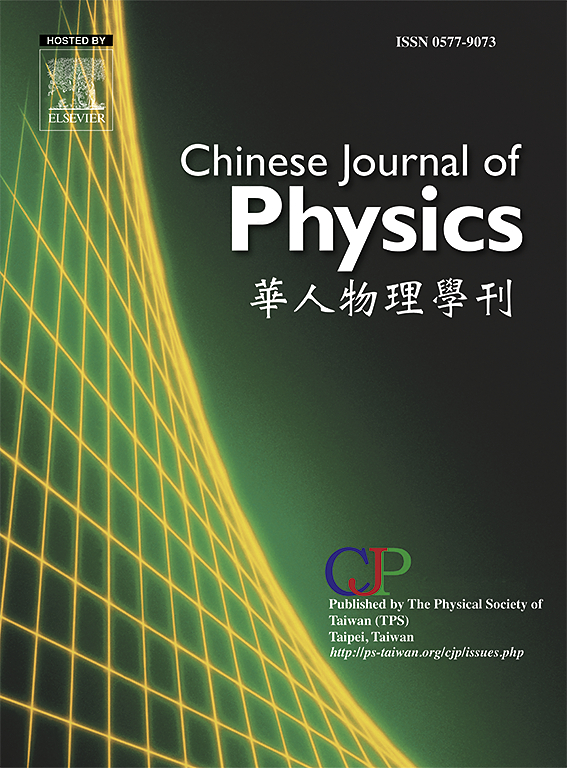Enhanced Birefringence Modes of surface plasmon polariton induced by a hybrid chiral QD medium
IF 4.6
2区 物理与天体物理
Q1 PHYSICS, MULTIDISCIPLINARY
引用次数: 0
Abstract
In this study, we propose a detailed theoretical approach to explore the birefringent surface plasmon polariton (SPP) modes at the interface of a hybrid nanostructure. This nanostructure comprises a gold (Au) metal layer combined with a chiral quantum dot (CQD) medium. The characteristics of SPP in this hybrid configuration are derived using detailed analytical methods based on Maxwell’s equations, with appropriate boundary conditions applied to ensure accuracy. Additionally, the dynamics of the CQD system are analyzed using the density matrix formalism, which enables a detailed description of the quantum interactions within the medium. Our analysis demonstrates that the birefringent SPP modes, discernible in both absorption and dispersion spectra, can be effectively controlled by manipulating key parameters such as inter-dot tunneling strength and spontaneous emission rates. This tunability also extends to the propagation length and phase shift of the birefringent SPP beams, which can be modulated under the same set of conditions. The ability to control these birefringent SPP modes offers significant potential for the development of advanced imaging systems and the design of compact, efficient nanophotonic devices. By utilizing the interaction between the CQD and the metallic interface, our study not only enhances the understanding of SPP behavior in hybrid nanostructures but also opens up new possibilities for the application of photonic technologies at the nanoscale. The engineering of these birefringent SPP modes could lead to substantial advancements in high-resolution imaging, the fabrication of novel photonic circuits, and other areas critical to the progression of nanophotonics.

杂化手性量子点介质诱导表面等离子激元极化子的增强双折射模式
在这项研究中,我们提出了一种详细的理论方法来探索混合纳米结构界面上的双折射表面等离子体激元(SPP)模式。该纳米结构由金(Au)金属层和手性量子点(CQD)介质组成。利用基于麦克斯韦方程组的详细解析方法推导了该混合结构中SPP的特性,并采用了适当的边界条件以保证精度。此外,使用密度矩阵形式分析了CQD系统的动力学,从而可以详细描述介质内的量子相互作用。我们的分析表明,双折射SPP模式可以通过控制点间隧道强度和自发发射率等关键参数来有效地控制,在吸收和色散光谱中都可以识别。这种可调性也扩展到双折射SPP光束的传播长度和相移,可以在相同的条件下进行调制。控制这些双折射SPP模式的能力为开发先进的成像系统和设计紧凑、高效的纳米光子器件提供了巨大的潜力。通过利用CQD与金属界面之间的相互作用,我们的研究不仅增强了对杂化纳米结构中SPP行为的理解,而且为光子技术在纳米尺度上的应用开辟了新的可能性。这些双折射SPP模式的工程可以导致高分辨率成像的实质性进步,新型光子电路的制造,以及其他对纳米光子学发展至关重要的领域。
本文章由计算机程序翻译,如有差异,请以英文原文为准。
求助全文
约1分钟内获得全文
求助全文
来源期刊

Chinese Journal of Physics
物理-物理:综合
CiteScore
8.50
自引率
10.00%
发文量
361
审稿时长
44 days
期刊介绍:
The Chinese Journal of Physics publishes important advances in various branches in physics, including statistical and biophysical physics, condensed matter physics, atomic/molecular physics, optics, particle physics and nuclear physics.
The editors welcome manuscripts on:
-General Physics: Statistical and Quantum Mechanics, etc.-
Gravitation and Astrophysics-
Elementary Particles and Fields-
Nuclear Physics-
Atomic, Molecular, and Optical Physics-
Quantum Information and Quantum Computation-
Fluid Dynamics, Nonlinear Dynamics, Chaos, and Complex Networks-
Plasma and Beam Physics-
Condensed Matter: Structure, etc.-
Condensed Matter: Electronic Properties, etc.-
Polymer, Soft Matter, Biological, and Interdisciplinary Physics.
CJP publishes regular research papers, feature articles and review papers.
 求助内容:
求助内容: 应助结果提醒方式:
应助结果提醒方式:


